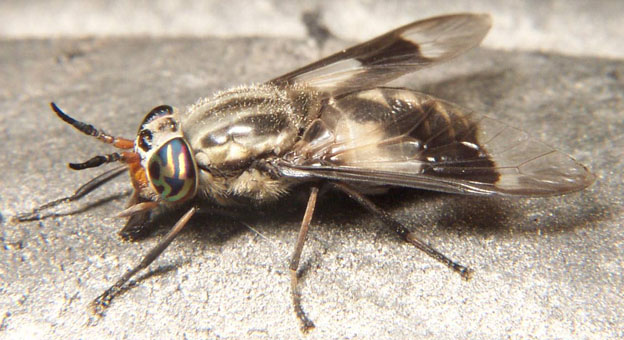Shoo fly, don’t bother me! The ‘Bug Man’ on summer pests

The deer fly (Chrysops callidus) can be a major summer pest. Females us their mandibles to make a cross-shaped incision in the skin and then lap up the blood. Their bite typically results in pain and itch.
High temperatures and drought-like conditions have kept Ontario’s mosquito population in check this summer.
But while that may come as good news to hikers and campers, Marvin Gunderman says other biting insects are doing just fine.
“Mosquito activity is down, but deer flies and horseflies are doing quite well,” said Gunderman, curator of entomology and insect taxonomist at McMaster. “They’re both found in moist places near water or in the forest leaf litter. It takes a long drought to dry out those areas, so they’re doing fine.”
He says he’s noticed overall insect populations appear to be down this summer.
“There just doesn’t appear to be as many insects out as in other years,” he says.
Gunderman, known at McMaster’s “Bug Man”, says many insects survived the area’s mild winter, resulting in a springtime surge of some types of bugs. Current conditions, however, have dried up standing water found in places like eavestroughs, eliminating mosquito breeding areas.
Gunderman points to the lack of rain to potentially delay the emergence of other insects, too.
“Insects that feed on plants or the roots of plants and grasses are not getting as many nutrients,” he says. “Their development has probably slowed up a lot, and they might take a lot longer to emerge.”
Japanese beetle larvae, for instance, feed on the roots of grasses and plants, while adults eat grass blades. With lawns province-wide going brown, these and other beetles are in tough.
But things can change in a hurry, says Gunderman.
“It’s the old ebb and flow. If all of a sudden we get some rain, that’s going to green things up a little bit and those insects are going to catch up.”
Gunderman says fluctuating insect populations can be felt up and down the food chain.
“Take a drop in the number of mosquitoes, for instance. Look at the number of animals that feed on them: toads, frogs, bats. It’s going to affect those predators. And if there’s a surge in the number of horseflies and deerflies, then their predators – dragonflies, damselflies – will do well.”
Gunderman, who is regularly called upon to help identify insects, has already received a number of photos of the grape vine beetle. He says their sudden appearance may indicate that they’re having a good season.
“Every year is something different.”

